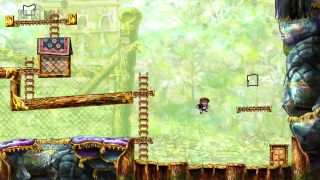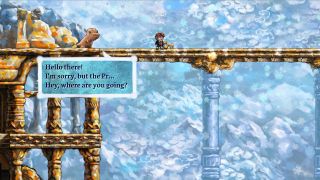Why Braid, the indie poster boy’s magnum opus, doesn’t Blow us away nearly a decade later
Is Braid still worth playing? Let's take a look at the archetypal indie game

I remember the furtive chatter more than the experience of playing it: Braid was the game that redefined games. It was clever in ways that defied explanation, they said, and it was made by one enigmatic man who became the reluctant star of a movie about the scene he reluctantly figureheaded. The Cult of Jonathan Blow lives on today in devotees who try to evangelise the genius within The Witness’ punishing volume of maze puzzles, but it all began in 2008.
I was destined never to like it, of course. There’s something in my brain that flips an irreversible ‘I hate it’ switch whenever people effuse about the Next Big Thing, because I’m a broken, pathetic man. Nevertheless I did play it in situ, and my thoughts at the time could be summarised as follows: Jonathan Blow is cleverer than me, and he’s reminding me of it with each of these dastardly little puzzles. I don’t like this so I’m going to give up.

But time matures the human condition, and almost a decade after it first bewitched the gaming masses, I thought it might be nice to travel back in time, if you will, to Braid. Hungry for humble pie, ready to admit that my contrarian hard-wiring got in the way of my enjoying an obvious classic. My thoughts upon returning to Braid? Balls. Jonathan Blow is still cleverer than me.
Braid is still a fundamentally challenging game, and I can respect both the intention and the experience of that challenge. It’s difficult by its very nature, because its time-moulding mechanics are intended to deconstruct game design and smash preconceptions, like a watercolour-painted punk rock song about the Mario establishment. That’s how Blow characterised it at the time, actually: a challenge to the status quo.

That’s intrinsically interesting. Sometimes you have to see the status quo challenged in order to really see what it was in the first place, so Blow’s endeavour is a worthy one. And on a level, there’s a perverse enjoyment in pushing and pulling the same kind of pattern-led platform game enemies this way and that with the flow of time, subverting their behaviour for your own advantage. It’s a bit like bringing the console commands up, only more enjoyable. And as mechanics and narrative progress, in admirable harmony, Braid reveals further subversions of the norm: the role of the protagonist, the damsel in distress, and player agency.
But I’m meeting Blow more than halfway there. With all the will in the world, it’d be very hard to argue that the side-scrolling foes and ‘The Princess is in another castle’ damsel-saving actually represented the status quo in 2008, whether you’re talking about gameplay systems or narratives. If Braid had been released in 1992 it’d be a different matter, but this was a post-Gravity Gun age in which Half-Life 2’s devs had empowered us to subvert the shooter norm and use enemies, alive or dead, as ammunition against their colleagues. Post-“would you kindly” too, with Bioshock having thoroughly deconstructed player agency in its narrative the previous year. The biggest games in 2008 were Fallout 3, Left 4 Dead, GTA 4 et al – does Braid really have anything to say about those titles?

I digress. What stands out now in 2017 more than any high-mindedness is how well the art direction and the nuts and bolts of movement and interaction have aged. It’s in that way, with the surrounding hype now long quietened, that Braid is really enjoyable. Tim the time-traveller is still visually distinct, iconic even, and nothing in the intervening years has managed to outdo Braid’s own painterly vision of platforming. Above all, what stands out is the clarity of one creator’s vision, and how uncompromisingly they pursued it. Can’t knock that.
Sign up to the GamesRadar+ Newsletter
Weekly digests, tales from the communities you love, and more
This article originally appeared in Xbox: The Official Magazine. For more great Xbox coverage, you can subscribe here.
Phil Iwaniuk is a multi-faceted journalist, video producer, presenter, and reviewer. Specialising in PC hardware and gaming, he's written for publications including PCGamesN, PC Gamer, GamesRadar, The Guardian, Tom's Hardware, TechRadar, Eurogamer, Trusted Reviews, VG247, Yallo, IGN, and Rolling Stone, among others.
Most Popular



